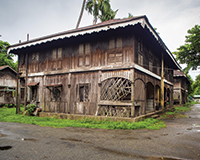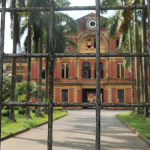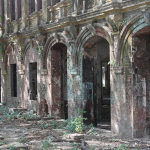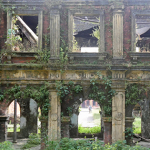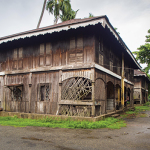Your first step into the inky blackness of the corridor is met with a cacophony of angry squeaks. There are rats somewhere in the darkness, and they do not want you there.
Welcome to the Pegu Club in Yangon. Once the most famous gentleman’s club in South-East Asia – the centre of the British social scene in colonial Burma – but now a rotting relic. Built in 1882 to serve British Army officers, it is now a home to rodents and stray dogs.
Steps are missing from the grand staircases, glass in the ornate diamond-patterned windows is broken and sections of the balconies, where gin and tonics were once sipped, have collapsed.
The Pegu Club is not unique. Across Yangon, British-built architectural gems are falling into disrepair. But a growing movement is working to preserve the city’s heritage.
The Yangon Heritage Trust is a non-governmental organisation set up by renowned Burmese historian Thant Myint-U in 2012 to protect Yangon’s urban heritage. In its efforts to identify buildings across the city with heritage value and to draw up plans for conservation zones, it also works with the government to develop stronger regulatory and legislative protection.
The hope is that overseas investment can not only fast-track the improvement programme, but can help move some of these relics on from a controversial political past.
Crumbling properties
Rupert Mann, programme manager at YHT, explains how foreign real estate investment could revitalise these crumbling properties, whether through replacement or refurbishment. “There are a number of buildings that detract from the original,” he says of the Pegu. “They could be demolished. It is one of those sites with scope for sympathetic new build.”
New uses for the old club – once frequented by the likes of Rudyard Kipling – must be considered sensitively, he adds.
“With Pegu, it has got a dark history,” he says. “Its symbolism has been of colonial repression, elitism, exploitation. That has to be considered when you talk of future use. We don’t, for example, think it should be an exclusive club again, where 99.9% of people can’t go.”
Another building no longer open to the public is the Secretariat. On a 16-acre city block, the red-brick complex, built in the late 19th century, was the seat of British power in Burma. But Mann says these buildings are defined by more than their colonial past.
“[The Secretariat] is not venerated because of the colonial administration,” he says. “This is the place where the martyrs [including Aung San Suu Kyi’s father, General Aung San] were assassinated; this is where the first [Burmese] parliament sat.”
And this is an example of where the argument for restoration is powerful.
“If these buildings were demolished, Myanmar would not lose colonial history but its own history and legacy,” says Mann.
The chances of a symbolic building such as the Secretariat being demolished are slim. The tender to renovate it was won by the Anawmar Art Group, a group of artists and art collectors, in 2012. The group says it will spend $50m (£35m) to turn the property into an art museum.
Heritage value
But what about the other buildings of heritage value that do not have the fame or size of the Secretariat? The UK-based Prince’s Foundation for Building Community estimates that between 1990 and 2011 as much as 35% of downtown Yangon – about 1,800 buildings – was destroyed.
These were usually residential properties, often with ground-floor retail, in downtown’s dense grid of streets. Over recent years, many have been torn down to make way for cheap condominium blocks.
“The problem is that the people who own it are not getting a yield,” says Ester van Steekelenburg, a consultant for the Asian Development Bank’s Cities Development Initiative for Asia. “The ground rent is just a couple of thousand kyat (£1.10). The only way to get out of that is to get into bed with a developer who will destroy it, put up a new build and give a couple of apartments to the owners.”
The CDIA is exploring ways to make the revitalisation of heritage buildings more attractive to investors. But in the case of larger, government-owned properties – such as the Secretariat – van Steekelenburg says the numbers don’t stack up: “They are just too big.”
She says the conditions attached to a government lease and the demand for cultural space at these properties means foreign investors are unlikely to be interested without a subsidy. “We propose putting in some sort of heritage fund,” she says. “That might make lease conditions more attractive.”
The CDIA normally carries out projects based around infrastructure, for which ADB can then provide loans to governments. But the urban heritage scheme is new territory.
Keeping ADB interested in Yangon is part of van Steekelenburg’s work. She says the bank could provide debt for the heritage fund, as well as for a housing microfinance fund – a way for downtown residents to pool their resources and renovate their own properties.
The election victory for the National League for Democracy will help to bring such projects to light, and could attract foreign investment in Burmese heritage. “The election result is very helpful,” she says. “The idea is that we are supposed to ready some projects that could be picked up by a new government.”
While plans for stronger legislative and regulatory conservation frameworks are being drawn up, one project is also trying to prove what can be achieved on the ground.
Turquoise Mountain, a not-for-profit organisation that preserves cultural heritage in Afghanistan, recently made its first foray into Myanmar. The group is renovating a residential and commercial property on downtown’s central Merchant Street.
The nine-month project, supported by the Prince’s Foundation and with funding from Canada’s government, involves “doing up the envelope of the building”, from restoring decorative features to fixing the roof.
Harry Wardill, Myanmar director at Turquoise Mountain, says: “One of the ladies upstairs from one of the bigger families – I watched her do it – would rush to switch off the electricity when it started raining. This is a sort of death-defying activity.”
The property is about 25,000 sq ft across 13 residential and commercial units, and used by 80 people, all of whom will stay there during the renovation.
Turquoise Mountain became involved in the project after a dispute between the building’s tenants and its owner.
The dispute turned out to be in Turquoise Mountain’s favour as, through YHT, the tenants sought an alternative to the owner’s redevelopment plans.
The big question is what sort of return overseas investors can expect to see. Wardill believes there are certain projects where there is money to be made.
One is the former Accountant-General’s office at 1 Pansodan Street, where the revenues from the export of teak, salt and opium were collected. The building’s red-tiled domes overlook the river, and inside there is a courtyard that Wardill thinks could be opened to the public. The other is the Edwardian Balthazar Building on Bank Street, which has fallen into disrepair. The CDIA has identified it as an opportunity for revitalisation.
Foreign investment
Turquoise Mountain is exploring setting up a special-purpose vehicle which, as a local business, could take in foreign investment with an internal rate of return for investors of about 20%, according to Wardill.
But he acknowledges many are waiting to see how the political landscape pans out.
For the YHT’s Mann, the election result is positive for preserving the city’s heritage. “We had good meetings with the NLD and they were very supportive,” he says.
Mann says Yangon has not yet made any “disastrous mistakes” like cities where heritage has been lost, such as Hong Kong, Shanghai and Kuala Lumpur.
He adds: “For the NLD, there is a sense of a strong, hopeful vision for the future – a vision of not making those mistakes and regretting them.”







